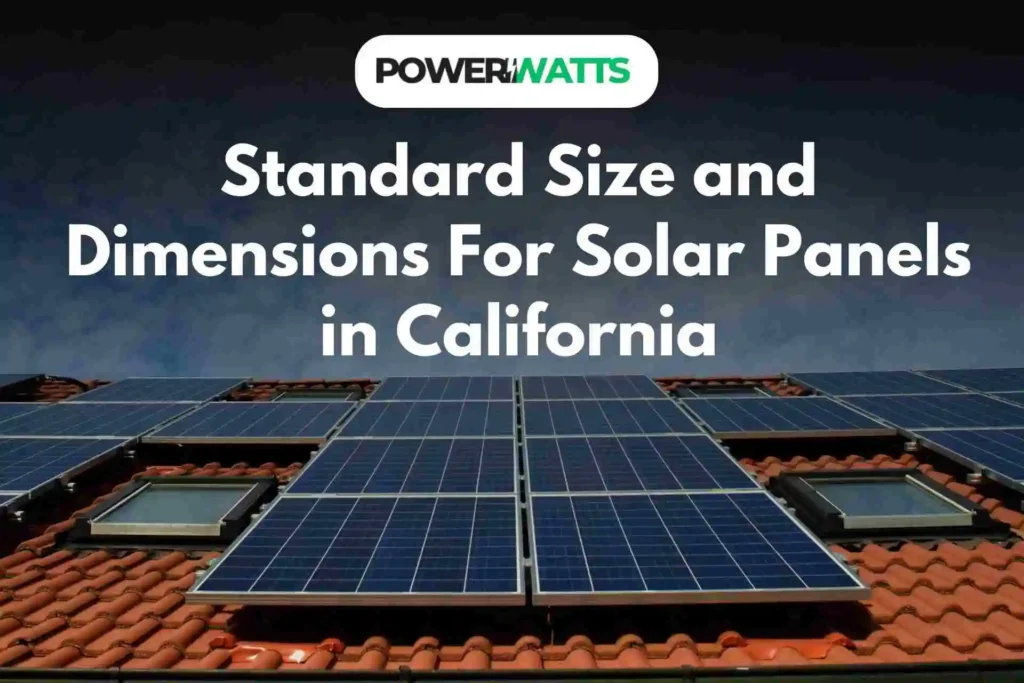As the number of solar energy increases, knowing the standard size and dimensions for solar panels in california becomes a basic thing for homeowners and business-oriented individuals. Here is a general overview of usual size and dimensions of solar panels to aid in planning and effectively boost solar energy systems to suit energy preferences and spaces.
Standard Size and Dimensions for Solar Panels in California
Residential Solar Panels
- Size and Dimensions: Residential solar panels are of a fairly standard size, although there might be some variance based on the manufacturer. But typically meant for residential use, solar panels may come with the following dimensions: about 65 inches by 39 inches (165 cm by 99 cm). Such solar panels are usually about 1.4 to 1.8 inches thick (3.5 to 4.5 cm).
- Power Output: Most residential solar panels have a power output of between 250 and 400 watts. Physical size may vary in that more efficient panels, while slightly smaller, can pack a greater punch regarding power output.
- Weight: The average weight of residential solar panels comes in at around 40 to 50 pounds, or 18 to 23 kg. Weight may be different according to the construction material used and how the panel is actually put together.
Commercial Solar Panels
- Size and Dimensions: The size for commercial solar panels is somewhat larger compared to residential solar panels since they collect more energy. The typical dimensions for commercial solar panels are about 77 inches by 39 inches (195 cm by 99 cm), while the average thickness level is likewise about 1.4 to 1.8 inches (3.5 to 4.5 cm).
- Power Output: The regular power output of commercial solar panels depends on the panel power capacity, usually ranging between 300 to 500 watts, taking into consideration the factor of the new efficient cell technology and the fact that it is larger in size.
- Weight: On average, commercial panels range between 50 and 60 pounds. The extra materials used in its extra-large dimensions account for increased weight in commercial panels.
Factors Influencing the Size and Dimensions of the Panel
Panel Efficiency and the Technology Used
Size is considerably affected by the efficiency of solar panels. The higher the efficiency rating, the higher the wattage output per square foot will be. Thus, the size is lowered in that case where the panel is producing a large percentile of power. Another factor affecting the dimensions of the panel is technological advancement, comprising the use of bifacial solar panels or different cell configurations.
Mounting and Installation Aspects
Solar panel size and dimensions shall be considered relative to a mounting system and available installation space. Pane spacing must be properly implemented to achieve maximum performance and maintenance access. The inter-row spacing shall be designed for major factors such as roof size, the angle at which the tilt is to be mounted, and shading exposure.
Manufacturer Variations
Different manufacturers make panels of somewhat different sizes and outputs. There are standard sizes, but, again, check the specific product list for compatibility of installation.
Types of Solar Panels and Their Sizes
Monocrystalline Panels
Monocrystalline panels are very efficient, and their footprint is usually slightly smaller than that of polycrystalline panels for the same power output. They are the best for installations where space is a constraint.
Polycrystalline Panels
Polycrystalline panels are available in considerably larger sizes in comparison to monocrystalline panels with the same power output; therefore, many installations are not observed. These solar panels have been carried out on larger telecommunication projects where space is not a constraint; therefore, polycrystalline has been in demand.
The former is not as efficient as the latter, but they are more flexible in terms of installations, and their dimensions can vary. They can take on the conformity of surfaces that the traditional panels cannot.
How Panel Size Affects System Design
Roof Space and Layout
The available roof space is what will really determine just how many panels you can be able to install and how to have them arranged so their faces stay exposed. It really helps to know what the standard sizes are in your layout optimization to the available space for maximum efficiency.
Implications on System Efficiency and Output
More efficient panels, however, also have a large impact on the size of affected systems. The remaining room on the roof can thus provide space for future expansions or other uses.
Aesthetic Considerations
Larger panels cover more of your roof and potentially affect the aesthetic appeal of your home or building. Homeowners are looking to install a system and maintain their homes’ aesthetic appeal. Scaling, or balancing impact against panel size, is often an important consideration for many.
Conclusion
For systems in California, typical sizes and dimensions are very different between residential applications and commercial. For residential, the panels are usually about 65 by 39 inches, and for commercial, they run about 77 by 39 inches. From there, knowledge of these dimensions would help in the planning and installation of systems to fit space and accommodate the associated necessary energy requirement. Solar technology has advanced. In addition, manufacturers are now offering various panel sizes and efficiency. Speak to an installer to know what will work best for you.
Get a Quote In case you are interested in integrating an inverter with a solar charger into your power system, do not hesitate to contact us today for your custom quote.
Frequently Asked Questions
What Is the Size of a Home Solar Panel?
A typical residential solar panel in California is approximately 65 inches by 39 inches (165 cm by 99 cm). These dimensions may indeed vary slightly between manufacturers and models.
How do the dimensions of commercial solar panels compare to residential panels?
Commercial solar panels are, in general, bigger compared to residential ones. The normal measurements for commercial solar panels are about 77 inches by 39 inches, or 195 centimetres by 99 centimetres. They typically have greater power output, ranging from 300 to 500 watts.


